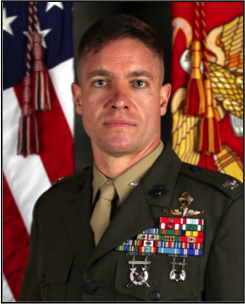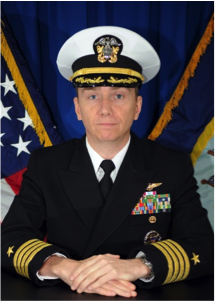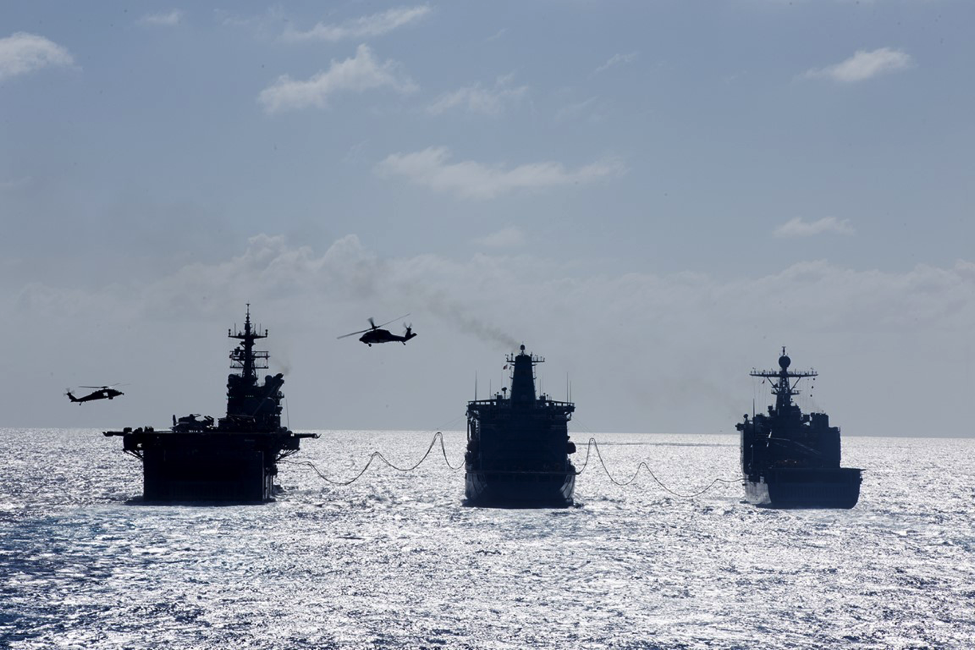USS San Diego, At Sea, At Sea - Military Sealift Command fleet replenishment oiler USNS Henry J. Kaiser (T-AO 187) refuels both the USS Makin Island, left, and the USS Comstock, right, as part of an underway replenishment in the Pacific Ocean, Aug. 4, 2014. The 11th MEU and Makin Island Amphibious Ready Group are a sea-based, expeditionary crisis response force capable of conducting amphibious missions across the full range of military operations. (U.S. Marine Corps photo by Gunnery Sgt. Rome M. Lazarus/Released)
USMC Returning Commander Speaker Series Event
The Center for Adaptation and Innovation at the Potomac Institute for Policy Studies hosted a program presented by the USMC Returning Commander Speaker Series on Thursday, 16 April 2015 featuring the commanders of the Makin Island Amphibious Ready Group (ARG) and the 11th Marine Expeditionary Unit (MEU). During their seven month deployment, Captain Stephen McKone, USN, and Colonel Matthew Trollinger, USMC, led a Navy-Marine Corps team that completed missions that included conducting some of the first strikes in support of Operation Inherent Resolve, humanitarian assistance in the northwestern Hawaiian islands, and theater security cooperation exercises in Bangladesh, Malaysia, Kuwait and Saudi Arabia.
The deployment began with a large-scale sustainment training package in Hawaii. While the ships of the ARG steamed west from San Diego, Marines and Sailors pushed ashore, conducting an insert of forces from a distance of more than 800 nautical miles via MV-22 Osprey. Concurrently, Marines from the Reconnaissance detachment conducted bilateral training with Bangladeshi Special Forces. The ARG/MEU moved to Hong Kong next, and conducted a port call and liberty before transiting through the South China Sea and the Senkaku islands to engage with the Malaysian Marine Corps during a scheduled bilateral training event. In Malaysia, Marines trained alongside members of the Malaysian Armed Forces, culminating in a combined demonstration of projection of power from the sea for gathered regional leaders.
In Central Command, the MEU worked with British Royal Marines and Sailors, as well as the Kuwaiti Armed Forces in a multi-ship combined amphibious exercise, culminating in a combined amphibious assault with service members from all three nations. Additionally, while simultaneously supporting Operation Inherent Resolve and the ongoing crisis in Yemen, the MEU continued the tradition of training with the Kingdom of Saudi Arabia during a multi-day theatre security cooperation exercise. With ongoing uncertainty associated with the circumstances in Yemen, the 11th MEU was postured, and integrated with the broader Joint force, to respond to emergent tasking when called upon. Finally, the MEU conducted some of the first strikes in support of Operation Inherent Resolve, and maintained a constant presence to respond to emerging situations across the region.
In their presentation, CAPT McKone and Col Trollinger highlighted the significant role of the Special Operations Force Liaison Element (SOFLE) which not only brought tremendous capability by plugging the ARG/MEU into the Global Special Operations Forces (SOF) Network, but also acted as a key enabler for SOF/ARGMEU interoperability. By having the six man SOFLE team aboard providing the connective tissue into the Global SOF Network, the ARG/MEU leveraged complimentary capabilities which provided them with a “warm start”, having the complete SOF picture of the environment they were entering into vice a “cold start” where in the past they unsure of the environment and must be spun up.
Other takeaways include the established cooperative relationship between the 11th MEU and the Special Purpose Marine Air Ground Task Force Crisis Response Central Command (SPMAGTF-CR-CC); the tremendous capability the MEU brings to bear to achieve regional security objectives in a steady state environment, while not degrading theater reserve/crisis response capability; the sustained posture of be prepared to missions comes at a cost to material readiness and proficiency and sustained split/disaggregated employment impacted advertised MEU capability.
The Center for Adaptation and Innovation (CAI) identifies and defines new and potentially disruptive defense capabilities. Specifically, the Potomac Institute for Policy Studies established CAI to assist senior defense leaders grappling with the most demanding issues and problems posed by a complex and uncertain security environment.
Col Matthew G. Trollinger
 Graduated in 1990 with a Bachelor’s Degree in Civil Engineering from Old Dominion University.
Graduated in 1990 with a Bachelor’s Degree in Civil Engineering from Old Dominion University.
Deployed twice as first a rifle platoon commander then company commander to Okinawa, Japan as part of the Marine Corps’ Unit Deployment Program.
Deployed to Somalia with Regimental Combat Team-7 to participate in Operation Restore Hope, as well as with Battalion Landing Team 2/5, 11th Marine Expeditionary Unit to the Western Pacific.
As the Operations Officer for Battalion Landing Team 1/8, deployed with 22nd MEU to the Mediterranean Sea.
Commanded First Fleet Antiterrorism Security Team (FAST) Company, MCSFBn, routinely deploying his platoons in support of 5th, 6th and 7th Fleet Commanders. In November 2003, he led a Task Force comprised of a portion of his FAST Company, along with MCSFBn enablers, Navy EOD, and Army and Air Force military working dogs for a seven month security mission at the Coalition Provisional Authority Headquarters in Baghdad, Iraq.
Served at the Joint Warfighting Center, USJFCOM, where his duties included integrating warfighter capability improvement programs in the joint training environment for assessment and validation.
As the Operations Officer for the 24th MEU, deployed to Afghanistan with the MEU was re-tasked to conduct combat operations in Regional Command South.
From August 2011 to June 2012, was the Commandant of the Marine Corps Fellow with the Center for Strategic and International Studies, where he worked on projects related to future ground force capabilities, counterterrorism and national security strategy.
In June 2012, he was assigned as the Military Assistant to the Deputy Undersecretary of the Navy for Plans, Policy, Oversight and Integration.
CAPT Stephen McKone
 Captain McKone spent his childhood living in various locations in Africa, Europe, and the Middle East while his parents were on assignment with the U.S. State Department. He is a 1991 graduate of the United States Naval Academy.
Captain McKone spent his childhood living in various locations in Africa, Europe, and the Middle East while his parents were on assignment with the U.S. State Department. He is a 1991 graduate of the United States Naval Academy.
Upon graduation he reported to USS SARATOGA (CV-60) for duty as Assistant Air Transport Officer. Upon completion of flight training in Corpus Christi, TX and Pensacola, FL in March 1994, Captain McKone was designated a Naval Aviator. Prior to reporting to HSL-40 in Mayport, FL for training in the SH-60B SEAHAWK, he served as a Search and Rescue (SAR) pilot flying the UH-1N helicopter for NAS Corpus Christi.
In June 1995 Captain McKone reported to HSL-44 in Mayport, FL. He deployed aboard USS VICKSBURG (CG-69) to the Arabian Gulf in support of Operation SOUTHERN WATCH and the oil embargo against Iraq. During his second deployment, he served as the Assistant Officer in Charge and Maintenance Officer for Detachment SEVEN in USS UNDERWOOD (FFG-36).
Captain McKone was assigned to HSL-40 in May 1998 as a SH-60B Fleet Replacement Squadron (FRS) Instructor Pilot. He served as the Public Affairs Officer, Communications Officer, Quality Assurance Officer and NATOPS Officer.
Rotating back to sea duty in October 2000, he reported as Flag Lieutenant and Aide to Commander Carrier Group THREE. During this tour he deployed onboard USS CARL VINSON (CVN-70) in support of Operation ENDURING FREEDOM.
In August 2002 Captain McKone reported to HSL-48 in Mayport, FL for his department head tour. He deployed as the Officer in Charge of Detachment EIGHT onboard USS ANZIO (CG-68) during an accelerated deployment in support of OPERATION IRAQI FREEDOM. Under his leadership as Maintenance Officer, the “Vipers” won the 2004 COMHSLWINGLANT Golden Wrench Award. Additionally, he was chosen as the HSL-48 2003 Officer of the Year.
Captain McKone's next assignment was to Operations Team THREE, National Military Command Center, Operations Directorate, the Joint Staff. He served as Assistant Deputy Director for Operations, Senior Emergency Action Officer, Global Strike Advisor and Surveillance Officer.
Captain McKone reported as the HSL-51 Executive Officer in August 2007. He assumed command of HSL-51 in December 2008 as the 14th Warlord Commanding Officer. Under his subsequent leadership the Warlords were awarded the 2009 CNAP Battle ‘E’, COMHSMWINGPAC Golden Wrench, and Golden Anchor for retention excellence.
Post command, Captain McKone served as the Air Officer in USS WASP (LHD 1). He was then selected for Major Command at Sea and reported to Amphibious Squadron FIVE in April 2013 as Deputy Commander. Captain McKone assumed command of Amphibious Squadron FIVE in December 2014 while deployed to the Fifth Fleet Area of Operations.

